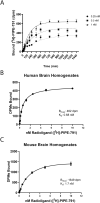Discovery of a brain penetrant small molecule antagonist targeting LPA1 receptors to reduce neuroinflammation and promote remyelination in multiple sclerosis
- PMID: 38719983
- PMCID: PMC11079064
- DOI: 10.1038/s41598-024-61369-9
Discovery of a brain penetrant small molecule antagonist targeting LPA1 receptors to reduce neuroinflammation and promote remyelination in multiple sclerosis
Abstract
Multiple sclerosis (MS) is a chronic neurological disease characterized by inflammatory demyelination that disrupts neuronal transmission resulting in neurodegeneration progressive disability. While current treatments focus on immunosuppression to limit inflammation and further myelin loss, no approved therapies effectively promote remyelination to mitigate the progressive disability associated with chronic demyelination. Lysophosphatidic acid (LPA) is a pro-inflammatory lipid that is upregulated in MS patient plasma and cerebrospinal fluid (CSF). LPA activates the LPA1 receptor, resulting in elevated CNS cytokine and chemokine levels, infiltration of immune cells, and microglial/astrocyte activation. This results in a neuroinflammatory response leading to demyelination and suppressed remyelination. A medicinal chemistry effort identified PIPE-791, an oral, brain-penetrant, LPA1 antagonist. PIPE-791 was characterized in vitro and in vivo and was found to be a potent, selective LPA1 antagonist with slow receptor off-rate kinetics. In vitro, PIPE-791 induced OPC differentiation and promoted remyelination following a demyelinating insult. PIPE-791 further mitigated the macrophage-mediated inhibition of OPC differentiation and inhibited microglial and fibroblast activation. In vivo, the compound readily crossed the blood-brain barrier and blocked LPA1 in the CNS after oral dosing. Direct dosing of PIPE-791 in vivo increased oligodendrocyte number, and in the mouse experimental autoimmune encephalomyelitis (EAE) model of MS, we observed that PIPE-791 promoted myelination, reduced neuroinflammation, and restored visual evoked potential latencies (VEP). These findings support targeting LPA1 for remyelination and encourage development of PIPE-791 for treating MS patients with advantages not seen with current immunosuppressive disease modifying therapies.
© 2024. The Author(s).
Conflict of interest statement
All authors, while engaged in the research pertaining to this paper, were employees of Contineum Therapeutics. Contineum Therapeutics has filed patent applications related to the subject matter of this paper.
Figures








Similar articles
-
Targeting the muscarinic M1 receptor with a selective, brain-penetrant antagonist to promote remyelination in multiple sclerosis.Proc Natl Acad Sci U S A. 2024 Aug 6;121(32):e2407974121. doi: 10.1073/pnas.2407974121. Epub 2024 Jul 31. Proc Natl Acad Sci U S A. 2024. PMID: 39083422 Free PMC article.
-
Activation of Macrophages by Lysophosphatidic Acid through the Lysophosphatidic Acid Receptor 1 as a Novel Mechanism in Multiple Sclerosis Pathogenesis.Mol Neurobiol. 2021 Feb;58(2):470-482. doi: 10.1007/s12035-020-02130-x. Epub 2020 Sep 24. Mol Neurobiol. 2021. PMID: 32974731
-
Nudging oligodendrocyte intrinsic signaling to remyelinate and repair: Estrogen receptor ligand effects.J Steroid Biochem Mol Biol. 2016 Jun;160:43-52. doi: 10.1016/j.jsbmb.2016.01.006. Epub 2016 Jan 14. J Steroid Biochem Mol Biol. 2016. PMID: 26776441 Free PMC article. Review.
-
The protein kinase C modulator bryostatin-1 therapeutically targets microglia to attenuate neuroinflammation and promote remyelination.Sci Transl Med. 2025 Jan 8;17(780):eadk3434. doi: 10.1126/scitranslmed.adk3434. Epub 2025 Jan 8. Sci Transl Med. 2025. PMID: 39772770
-
FGF/FGFR Pathways in Multiple Sclerosis and in Its Disease Models.Cells. 2021 Apr 13;10(4):884. doi: 10.3390/cells10040884. Cells. 2021. PMID: 33924474 Free PMC article. Review.
Cited by
-
LPAR3: a shared target for neurodegenerative diseases?Neural Regen Res. 2025 Dec 1;20(12):3527-3528. doi: 10.4103/NRR.NRR-D-24-01024. Epub 2024 Dec 7. Neural Regen Res. 2025. PMID: 39665827 Free PMC article. No abstract available.
-
Revolutionizing Neuroimmunology: Unraveling Immune Dynamics and Therapeutic Innovations in CNS Disorders.Int J Mol Sci. 2024 Dec 19;25(24):13614. doi: 10.3390/ijms252413614. Int J Mol Sci. 2024. PMID: 39769374 Free PMC article. Review.
References
-
- Schmitz K, Brunkhorst R, de Bruin N, Mayer CA, Haussler A, Ferreiros N, Schiffmann S, Parnham MJ, Tunaru S, Chun J, Offermanns S, Foerch C, Scholich K, Vogt J, Wicker S, Lotsch J, Geisslinger G, Tegeder I. Dysregulation of lysophosphatidic acids in multiple sclerosis and autoimmune encephalomyelitis. Acta Neuropathol. Commun. 2017;5(1):42. doi: 10.1186/s40478-017-0446-4. - DOI - PMC - PubMed
-
- Lorrain, K. I., Poon, M. M., Baccei, J., Broadhead, A. Dearie, A., Green, A., Chan, J. R., Lorrain, D. L. LPA Receptors Modulate Oligodendrocyte Differentiation and Maturation (Society for Neuroscience, 2017).
Publication types
MeSH terms
Substances
LinkOut - more resources
Full Text Sources
Medical
Miscellaneous

